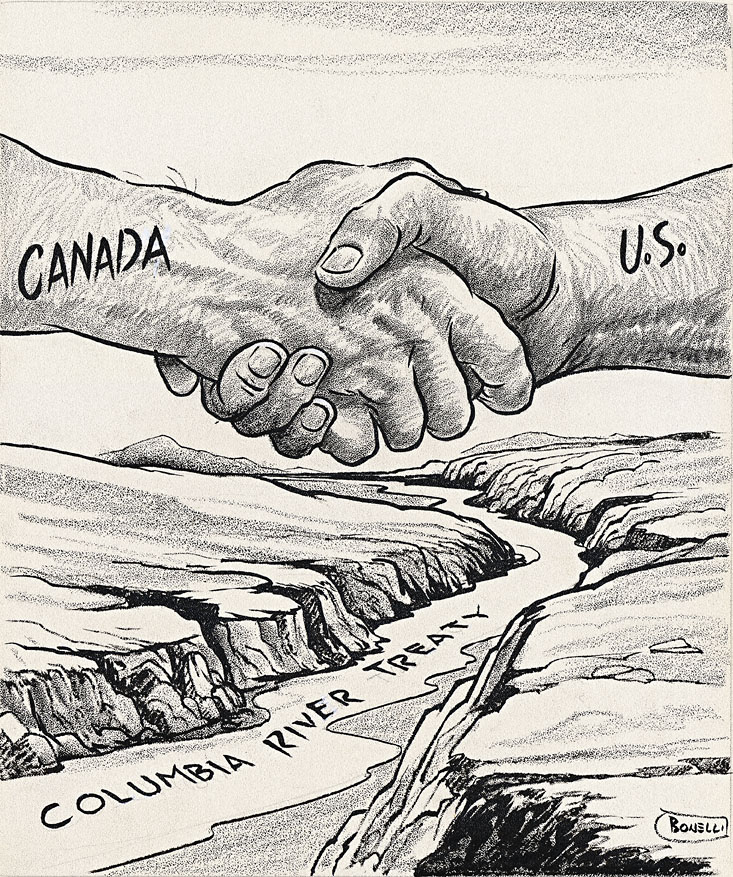- Catalog No. —
- Mss 5537
- Date —
- January 23, 1964
- Era —
- 1950-1980 (New Economy, Civil Rights, and Environmentalism)
- Themes —
- Environment and Natural Resources, Government, Law, and Politics
- Credits —
- Oregon Historical Society
- Regions —
- Columbia River
- Author —
- Carl Bonelli, Oregon Journal
Editorial Cartoon, O.K., It's a Deal
Carl Bonelli (1901–1981) was an editorial cartoonist for the Oregon Journal (1947-1971), for the Oregonian (1966-1968), and for the Gresham Outlook (1971-1974). This editorial cartoon appeared in the Journal on January 23, 1964. The art accompanied an editorial letter, “Eyes Kept on the Big Prize,” hailing a recent breakthrough in negotiations toward the Canadian ratification of the Columbia River Treaty and its subsequent effects on negotiations for the development of the Pacific Northwest-Pacific Southwest Intertie, a high-voltage transmission system linking the energy grids of much of the American West into a unified system.
According to the terms of the Columbia River Treaty, Canada committed itself to build three massive dams—Mica, Duncan, and Keenleyside—in the headwaters of the Columbia River watershed, designed to store the spring and summer snowmelt. The treaty also called for the construction of a fourth dam (Libby) in Montana, with a reservoir that would extend into Canadian territory. As compensation, Canada was entitled to half of the downstream benefits accrued to the United States, which amounted to $64.4 million in flood control plus a substantial amount of electrical energy.
Canadian ratification of the treaty stalled largely because by the early 1960s, British Columbia had already begun to construct its own hydropower projects in the Peace River watershed. Consequently, there existed no immediate market for the potential energy produced as a result of the treaty-authorized dams in Canada. The impasse was broken in December of 1963 when three private and eight public utilities from the U.S. Northwest offered to purchase Canada’s entitlement of electricity for thirty years at a cost of $254.4 million, subsequently forming the Columbia Storage Power Exchange to issue bonds to cover the payment. British Columbia then used the money to pay for the three treaty-stipulated dams.
Canada ratified the treaty in September of 1964, and construction of the dams began soon after. The increased storage provided by the Canadian projects allowed the United States to significantly expand the power-producing potential of dams downstream, most notably with the addition of a third powerhouse at Grand Coulee, a second powerhouse at Bonneville, and increased generating capacity at John Day.
Further Reading:
Krutilla, John V. The Columbia River Treaty: The Economics of an International River Basin Development. Baltimore, Md., 1967.
Norwood, Gus. Columbia River Power for the People: A History of Policies of the Bonneville Power Administration. Portland, Oreg., 1981.
Written by Joshua Binus, © Oregon Historical Society, 2004.
